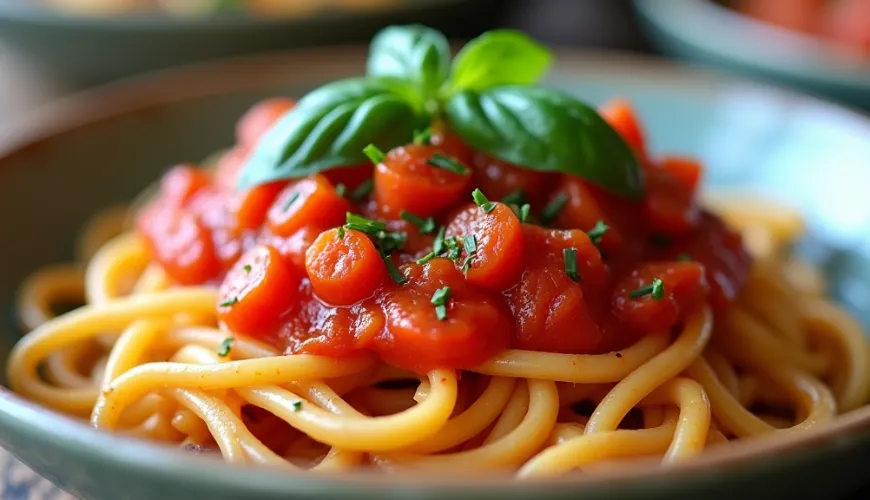
Don't have sugo at home? Here's why you should

What is Sugo and Why It Should Be the Foundation of Every Italian Kitchen
If anyone has ever tried to make authentic Italian pizza or pasta, they have surely encountered the term "sugo." And if not, perhaps it’s time to change that. In Italy, no household considers its kitchen complete without homemade tomato sugo – that magical, simple, intensely flavorful tomato sauce that forms the base for hundreds of dishes.
The word "sugo" in Italian literally means "juice" or "sauce," but in practice, sugo can be understood as a basic tomato sauce, which is the foundation not only for pizza but also for pasta, lasagna, vegetable dishes, or even meatballs. It’s a kitchen gem that can be simple yet surprisingly complex.
What Does a Classic Sugo Recipe Look Like?
The basic recipe for sugo is surprisingly straightforward: tomatoes, olive oil, garlic or onion, salt, and herbs. In some regions, carrots or celery are added, while others stick to pure flavors – it all depends on tradition, seasonality, and personal taste.
However, it’s important to start with quality ingredients. Proper sugo begins with tomatoes – not the watery kind, but meaty, fully ripe, and sweet ones. In summer, fresh San Marzano tomatoes are suitable, while out of season, it's wise to opt for canned peeled tomatoes whole, ideally those without added citric acid or other preservatives. It's worth tracking the origin – Italian brands like Mutti or La Bio Idea are usually a safe bet.
The preparation is simple: sauté garlic or onion in olive oil until golden, add the tomatoes (if using whole canned, it's good to crush or blend them beforehand), season with salt, and let it simmer on low heat. After forty to forty-five minutes, you'll have a thick, fragrant sauce that can be the base for many other recipes. Some add fresh basil leaves, others a bit of sugar to balance the acidity. Either way, sugo is not just a sauce – it's a philosophy of simplicity.
Sugo for Pizza
You might wonder if sugo for pizza differs from regular tomato sugo for pasta. And the answer is: yes, though not dramatically. Sugo for pizza is simpler, often uncooked, just flavored tomato purée or blended peeled tomatoes with olive oil, salt, and a bit of oregano. The goal is not to create a dominant flavor, but rather to provide a gentle and fresh base that supports the taste of the dough and other ingredients.
For example, the Neapolitan pizza Margherita – the embodiment of simplicity – is made with this type of sugo. The tomatoes are only mashed and seasoned, without cooking. When baked in the oven, the sauce heats up together with the dough and cheese, creating an authentic, slightly caramelized flavor that is unmistakable.
Conversely, if you're making homemade pizza in a conventional electric oven, it might be worthwhile to lightly cook the sugo to minimize the risk of the sauce making the pizza soggy. At the same time, you'll gain a deeper flavor that develops better in shorter baking.
Tomato Sugo as the Foundation of a Sustainable Kitchen
The reason why sugo is so popular is not just its taste. It is also an incredibly practical and sustainable ingredient. It can be prepared in large quantities, stored in the fridge for several days, or sterilized in jars to have on hand anytime. It allows you to easily use up excess tomatoes from your garden or market, preventing them from spoiling.
Imagine a household that harvests the last batch of tomatoes at the end of summer. Instead of making the tenth salad in a row, they turn them into several jars of sugo. In winter, when fresh vegetables are expensive and bland, this sugo comes as a godsend – just open, heat, add pasta, and within 15 minutes you have a full meal with the taste of summer.
Moreover, if the sugo is made at home without industrial additives, it is a pure and healthy alternative to store-bought sauces, which often contain added sugar, thickeners, or excessive salt. For parents of children, it's also an ideal way to subtly incorporate more vegetables into the diet.
How to Vary and Use Sugo Differently
One of the greatest advantages of sugo lies in its versatility. It can be sweet and mild one time, spicy and piquant another – depending on mood, occasion, or ingredients you have at home.
Here are several ways to transform sugo:
- Add chili and thyme for a spicier version ideal for meat dishes.
- Stir in butter and a little cream to create a velvety sauce for gnocchi.
- Use it as a base for shakshuka – add eggs and let them poach directly in the sugo.
- Mix with lentils or chickpeas to create a hearty vegetarian dinner.
- Prepare a pizza spread – mix sugo with ricotta and spread on baguettes or bread.
In any case, sugo is not just a recipe – it is an open gateway into the world of Italian cuisine, where fresh ingredients, simplicity, and respect for flavor play the main roles.
Traditional Italian Sugo vs. Modern Approaches
Nowadays, with more people interested in healthy eating, ecology, and local products, sugo is experiencing a renaissance. Many people are returning to homemade preparation, no store-bought jars, just honest homemade work and seasonal ingredients.
Italians often say: “Chi va piano, va sano e va lontano," loosely translated – those who go slowly, go healthily, and go far. And this perfectly captures the philosophy of making sugo. It’s not a dish for rushed days but for moments when you want to enjoy the process of cooking itself. Slow cooking of sugo on the stove, the aroma of herbs wafting through the kitchen, all contribute to an experience that creates not just food but also a memory.
When an older Italian chef was asked why his sauce is so special, he replied: "Because I cook it as if I were making it for someone I care about." And maybe that’s the secret of the entire sugo – it’s food that contains love, care, and patience.
So next time you're thinking about what to cook, try starting with sugo. You might find that the greatest magic comes from the simplest things.

